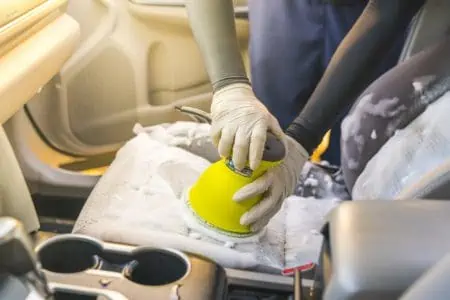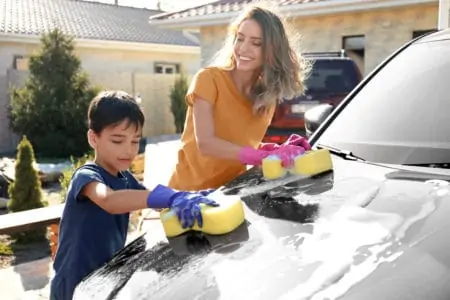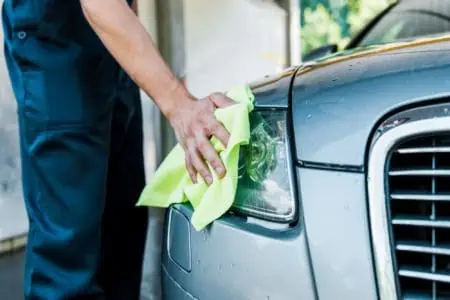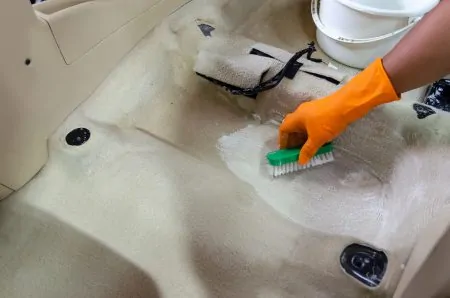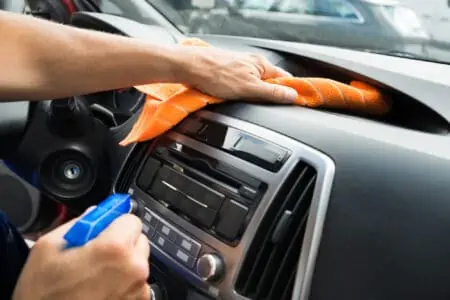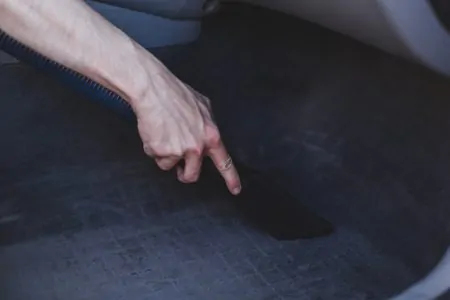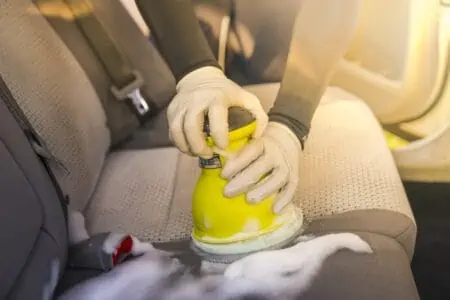If you’re embarrassed to pick people up in your car because of your messy, stained seats, you’re not alone. Spills, dirt, mud, and other accidents can quickly make your vehicle look and feel unhygienic.
However, hiring a company to clean your car can be expensive. Thankfully, you can deep clean the car seats all by yourself using our DIY methods.
Keep reading to learn how to clean car seats, shampoo them, and remove stubborn stains. Plus, we’ll leave you with a fantastic method for protecting them from further messes.
Key Takeaways
- Vacuum car seats before cleaning to remove debris and dirt.
- Use commercial cleaners, such as Chemical Guys Fabric Clean for fabric seats or Armor All Leather Care for leather seats.
- Household products like baking soda, vinegar, and toothpaste can also be used for cleaning car seats.
- Protect your car seats with seat covers or leather protector solutions to prevent stains and damage.
How to Clean Fabric Car Seats
Most of us have fabric car seats, so we’ll start with cleaning those. This method will involve vacuuming and removing stains using a commercial cleaner rather than household products. If you’re in the market for homemade cleaning recipes instead, read further on for our favorite hacks.
- Time: 1 hour
- Difficulty: Intermediate
What You’ll Need
- Commercial automotive cleaner or shampoo (we recommend Chemical Guys Fabric Clean)
- Spray bottle
- Water
- Stiff cleaning brush
- Handheld vacuum cleaner
- Microfiber towel
1. Vacuum the Seats
It’s vital to start with vacuuming. This removes debris from the fabric so that you don’t work it further into the fibers when you’re deep cleaning the seats.
Use your handheld vacuum cleaner, preferably with a flat upholstery attachment. Your regular vacuum cleaner might have this already — so you can definitely use that for this task.
If you have a crevice tool, use that to get into the nooks and crannies.
Cleaning Without A Vacuum
If you don’t have a handheld vacuum attachment, you can remove debris by wiping down your seats with a stiff cleaning brush followed by a microfiber cloth.
2. Tackle Stains
Many commercial car seat cleaners tackle stains as you go. So you won’t need to do this as a separate step.
However, if your chosen fabric cleaner doesn’t say it tackles stains, you will need to add in this step. For instance, the Chemical Guys cleaner requires a different dilution ratio for stains. You will need to create an 8:1 ratio of water and cleaner for stained areas of the seats.
Next, spray your car seat cleaner or shampoo onto the stained area and scrub it in well with your stiff cleaning brush. Leave it for 15 minutes (or whatever your packaging instructions suggest) before moving swiftly to the next step.
3. Prepare Your Cleaner
If your cleaner comes concentrated, you need to dilute it before using it. With Chemical Guys, you need to dilute a 20:1 ratio of water and cleaner. You can do this in a bucket, then use a cloth to apply the cleaner. We recommend diluting it in a spray bottle to make it easier.
4. Apply the Cleaner to the Seats
Before reading our method, check your product instructions first, as they may differ slightly.
In general, you will simply spritz the cleaner over the fabric seats, ensuring an even coating.
5. Scrub
Use your stiff-bristled brush to scrub the cleaner into the seats gently. With Chemical Guys — and many other cleaners — you’ll notice the formula foaming or sudsing up. This is a good indication that it’s working to break down stains so you can remove them easily in the next step.
Continue scrubbing until the formula has foamed up on all your seats.
6. Blot Up Cleaner
With your microfiber towel, blot up the cleaning solution residue. You can dampen the cloth slightly to make this step a little easier. Blotting up the cleaner will also remove lifted and broken down stains, leaving your car seats cleaner than they’ve been in a while!
If you notice that the car seats still look dirty, repeat the method with a less diluted cleaning mixture this time.
Try This
If you have a carpet extractor machine or hot water detail extractor, you can use that here instead of a microfiber towel.
7. Dry the Seats
Use a separate dry microfiber cloth to wipe excess water from the seats. Leave the car doors or windows open to let the interior fully air dry before entering the vehicle again.
How to Clean Leather Car Seats
When learning how to clean car upholstery, the methods vary for leather seats. You must treat leather seats with their own particular care. Here’s our favorite method for cleaning these types of seats.
- Time: 1 hour
- Difficulty: Intermediate
What You’ll Need
- Commercial automotive leather cleaner (we recommend Armor All Leather Care)
- Microfiber towels
- Bucket of water
- Handheld vacuum cleaner
- Leather cleaning brush
- Rubbing alcohol
- Cotton ball
- Dish soap
1. Vacuum the Seats
Use your handheld vacuum cleaner (preferably with the upholstery attachment) to vacuum debris from the seats. Use the crevice tool to get into all the nooks and crannies.
2. Apply Cleaner
Usually, leather cleaners already come in a spray bottle, so spritz it evenly over your seats. If your cleaner doesn’t come in a spray bottle, you can apply the cleaner to a microfiber towel first and then apply it to your seat via the cloth.
3. Scrub Seats
Dip your microfiber cloth into a bucket of water and wring it out extremely well.
Use the microfiber towel to scrub the cleaner into the seats. On stained areas, work the cleaner in with your leather cleaning brush. We recommend a specific leather cleaning brush since it’s soft enough to protect the leather but firm enough to help remove stains.
Continue this step until the seats are clean. Repeat if necessary.
4. Tackle Stains
If using a leather cleaning brush didn’t completely remove stains, there’s something else you can try. Pour a little bit of rubbing alcohol onto a cotton ball and blot the stained area. Continue this until the stain has been removed. Be patient because it may take a while.
Once the stain is gone, wipe the area with a microfiber cloth dipped in soapy water. Make sure to wring it out before dampening the seats!
5. Dry Seats
You never want to leave moisture on leather for too long as it’s a sure way to cause damage. So dry the seats well with a separate microfiber towel.
How to Clean Car Seats With Household Products
While professional car detailers love the above methods because the commercial cleaners pack a punch, not everybody wants to use those products.
If you’re looking for a DIY method using more natural or eco-friendly products, you can use household products you’ve already got lying around the house.
These six cleaners are great for cleaning car seats. We’ll walk through each one, how to use them, and what type of seats they’re safe for.
With Club Soda
If you’re wondering how to clean fabric car seats with club soda, we have a method for you to try.
Pour club soda into a spray bottle. Spritz the stained area, then scrub well with a stiff-bristled brush. Once the stain has lifted, wipe the area with a dampened microfiber towel.
We don’t recommend this for your entire car seat — instead, focus on stained areas. Otherwise, your car will stink of club soda, and it will be hard to remove the odor.
Don’t use this method on leather car seats.
With Baking Soda
Do you want to learn how to shampoo car seats at home without costly cleaners? Baking soda is a handy alternative for fabric car seats.
You can follow our above method for how to clean fabric car seats, but instead of using a commercial product, use baking soda. Your first thought might have been to do this with laundry detergent, but baking soda is more manageable and neutralizes odors.
You can spray the seats with water before sprinkling baking soda over the seats. Scrub the baking soda in with a stiff brush, then leave it on the seats for a couple of hours before wiping off and vacuuming.
The other option is to create a baking soda paste with a 1:1 baking soda and water solution. Add dish soap for extra cleaning power. Apply this directly to stained areas, scrub in well, then leave for 30 minutes before wiping away with a damp cloth.
With Vinegar
Distilled white vinegar is a slightly acidic and effective non-toxic cleaner. The good news about this one is that it’s safe for both fabric and leather car seats.
In a spray bottle, mix two cups of warm water, one cup of vinegar, and a squirt of dish soap. Swap it out for the commercial cleaner in the above steps. To prevent lasting damage, make sure to dry the seats extremely well, especially for leather.
This method is great for cleaning sweat stains off your seats.
With Toothpaste
If you’ve been here for a while, you’ll know that we like to surprise you with a toothpaste hack from time to time! This one is suitable for removing small stains on both fabric and leather car seats.
Make sure you use a white, non-gel toothpaste. Dab a little onto the paste and gently scrub with an old or unused toothbrush. Once the stain has lifted, wipe the toothpaste residue away with a dampened cloth before drying the seats well.
With Lemon Juice
Do you know how to clean car upholstery with lemon juice? We’re about to show you.
When life gives you lemons, clean your car! For best results, add cream of tartar to the mixture, but if necessary, you can do it without.
Mix lemon juice and cream of tartar into a bowl to create a paste. If going without the cream of tartar, simply squeeze the lemon juice into a bowl. Apply the cleaning solution onto the stain and leave it for 30 minutes before wiping away with a damp microfiber towel.
Expert Advice
Only use this technique on light-colored seats, as the lemon can have a slight bleaching effect. Before using this technique, always test in an inconspicuous spot to ensure it doesn’t damage your car seats.
With Nail Polish Remover
Like rubbing alcohol, nail polish remover contains alcohol that is handy for removing stains on leather seats. However, this works for fabric seats, too.
Pour nail polish remover onto a cotton ball and blot the stain until it is removed. Remember, this can take a long time! Once you’ve eradicated the stain, wipe the area with a microfiber cloth dampened with warm soapy water. Dry the seats thoroughly.
How to Protect Car Seats
When learning how to deep clean car upholstery, one of the smartest things you can do is protect the seats from further damage. Spills are inevitable in your car’s interior, and often, we can’t clean them up right away. No cleaning and driving, please!
So it’s important to take the initiative to protect your car seats. We’ll share the best method for both fabric and leather seats.
Protect Fabric Seats
For fabric seats, one of the best ways to prevent stains is to install seat protectors. These seat covers are easy to install and remove. When you come home and notice stains, simply remove the seat covers, toss them in the wash, and dry them before returning them to your car. It’s much quicker and easier than deep-cleaning your car seats whenever you notice a mess.
You can find seat covers in a variety of styles and colors. Plus, you can use these for protecting leather seats, too.
Protect Leather Seats
You can certainly install seat protector covers onto your leather seats, too. But if you like the luxurious look and feel of your leather seats, you won’t want to cover them up.
Instead, get a leather protector solution like the Chemical Guys Leather Protectant Serum. This provides year-round protection from cracks, fading, stains, and discoloration. You can use it in your car, but good news! It also works for your furniture, shoes, handbags, and more.
Tips For Keeping Car Seats Clean
If you find your car seats get dirty no matter what you do, we have some tips that you maybe haven’t thought about yet. Try these hacks for keeping your car clean in between deep cleaning sessions.
- Be smart about food and drink: We aren’t going to say don’t eat or drink in the car. This isn’t always possible, especially on long drives. But you can be smart about it. Have your food and drinks in bottles, closed cups, or meal trays to prevent mess.
- Keep wipes in the car: You can’t bring your vacuum, cleaning solution, and microfiber towels with you on the road. But you can keep wipes in the car for quickly cleaning up messes on the go. Just remember to pull over first!
- Create car travel bags: It’s tempting to toss everything into the passenger seat when you’re driving. But if something spills, it’s going to stain. Create a car travel bag to contain items while you’re driving.
- Avoid car sickness: If you know someone in your car is prone to car sickness, you can issue car sickness tablets, medicine, or wearable devices to prevent car sickness. Take frequent breaks. You might have to say no to your kids reading books or watching movies on the go. Consider other means of travel if at all possible.
- Water instead of juice: If you want to drink in the car, take water instead of juice, coffee, or tea. It’s less likely to stain.
- Car trash bag: Always equip your car with a trash bag or mini trash can before setting off on your journey. This way, everyone knows where to toss trash, and it won’t pile up on the floor or seats.
- Have towels or old t-shirts in the car: When someone does spill on the car seats, and you can’t make a quick stop, have towels or old t-shirts in the car to absorb the mess rather than wipes or paper towels. It’s more absorbent and will prevent bad staining.
- Lay down a towel: When jumping in the car after a sweaty gym session or sporting event, lay down a towel to prevent sweat stains.
Warning
When you want to disinfect your car seats, you might think of using bleach, ammonia, or cleaning with hydrogen peroxide. But we recommend against these as they can damage your car. Instead, use a steam cleaner or dish soap to disinfect parts of the car.
FAQs
Clean Enough for Carpooling
Carpooling saves money, but it can also cause embarrassment if your seats aren’t clean. However, now you have no excuse but to have spotless seats every week!
Our hour-long method is quick enough to do at the weekend and straightforward enough to do without a professional.
Always remember to clean your seats according to fabric type. There are different methods for fabric and leather seats. Don’t mix and match these!
